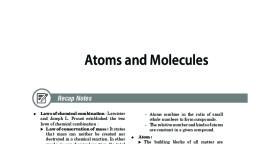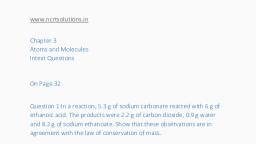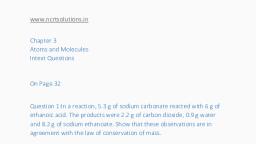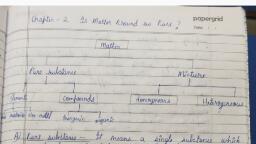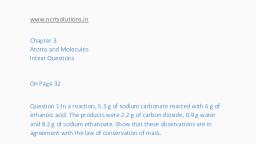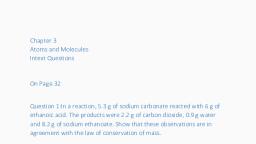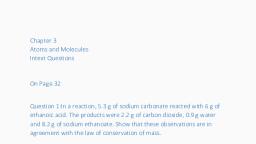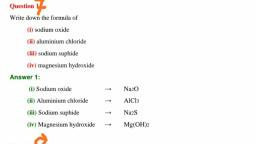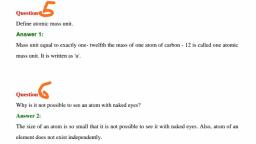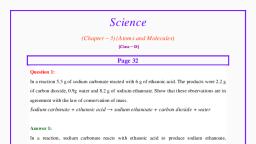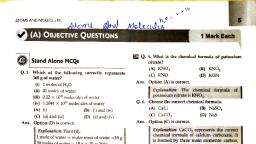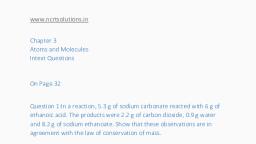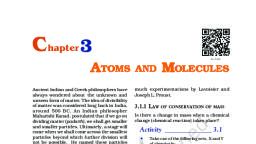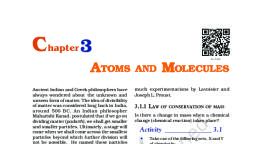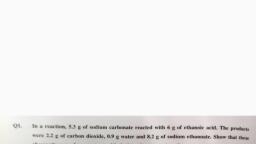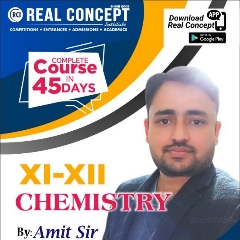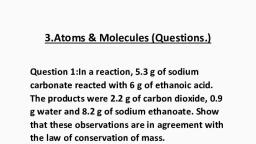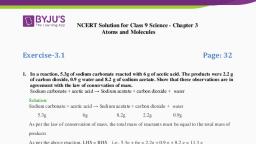Page 1 :
Chapter 3, Atoms and Molecules, Intext Questions, , On Page 32, Question 1:In a reaction, 5.3 g of sodium carbonate reacted with 6 g of, ethanoic acid. The products were 2.2 g of carbon dioxide, 0.9 g water, and 8.2 g of sodium ethanoate. Show that these observations are in, agreement with the law of conservation of mass., Sodium carbonate + ethanoic acid →sodium ethanoate + carbon +, dioxide + water, Solution:, Law of conservation of mass states that mass is neither created nor, destroyed during a chemical reaction., It means the mass remains the same. So, we add the mass of the, reactants on LHS and add the mass of all products on RHS, LHS = 5.3 g + 6 g = 11.3 g, RHS = 8.2g + 2.2g + 0.9g = 11.3g, LHS = RHS
Page 2 :
So, the observations are in agreement with the law of conservation of, mass., Question 2:Hydrogen and oxygen combine in the ratio of 1 : 8 by mass, to form water. What mass of oxygen gas would be required to react, completely with 3 g of hydrogen gas?, , Solution:'Law of constant proportions' states that composition of a, compound is always fixed., Applying this, ∵1 g of hydrogen gas combines with oxygen = 8 g, ∴3 g of hydrogen gas will combine with oxygen = 8 x 3 = 24 g, Question 3:Which postulate of Dalton's atomic theory is the result of the, law of conservation of mass?, Solution:Following postulate of Dalton's atomic theory is the result of, the law of conservation of mass. 'Atoms are indivisible particles, which, cannot be created or destroyed in a chemical reaction.', Question 4:Which postulate of Dalton's atomic theory can explain the, law of definite proportions?
Page 3 :
Solution:Following postulate of Dalton's atomic theory can explain the, 'law of definite proportions'., 'The relative number and kinds of atoms are constant in a given, compound.', On Page 35, Question 1:Define the atomic mass unit., Solution:One atomic mass unit (amu) is a mass unit equal to exactly onetwelfth (1/12th) the mass of one atom of carbon-12.' The relative atomic, masses of all the elements have been found with respect to an atom of, carbon-12., Question 2:Why is it not possible to see an atom with naked eyes?, , Solution:As an atom is extremely small in size, it is not possible to see it, with naked eyes., Generally radius of an atom is of the order of nanometres. For example,, atomic radius of hydrogen atom is 10-10m (or 10-1nm)., On Page 39, Question 1:Write down the formulae of
Page 5 :
(iv) Potassium nitrate, (v) Calcium carbonate., , Question 3:What is meant by the term chemical formula?, Solution:, , Chemical formula of a compound (or element) is the symbolic, representation of its composition. It represents, (i) The number and kind of atoms present per molecule of the, compound,, (ii) One mole of the compound,, (iii) Molar mass of the compound., Question 4:How many atoms are present in a, (i) H2S molecule and (ii) PO43−ion?, Solution:, (i) 2 atom of hydrogen + 1 atom of sulphur, = three (3) atoms (in a H2S molecule)., (ii) 1 atom of phosphorus + 4 atoms of oxygen, = five (5) atoms (in aPO43−ion).
Page 6 :
On Page 40, Question 1:Calculate the molecular masses of, H2, O2, CL2, CO2, CH4, C2H6, C2H4, NH3, CH3OH., Solution:, (i) Molecular mass of H2(hydrogen), = Atomic mass of hydrogen × 2, =1×2=2u, (ii) Molecular mass of O2 (oxygen), =Atomic mass of oxygen × 2, = 16 × 2 = 32 u, (iii) Molecular mass of CI2(chlorine), = Atomic mass of chlorine × 2, = 35.5 × 2 = 71 u, (iv) Molecular mass of CO2(carbon dioxide), = (Atomic mass of carbon × 1)+ (Atomic mass of oxygen × 2), = 12 + (16 × 2) = 12 + 32 = 44 u, (v) Molecular mass of CH4(methane), = (Atomic mass of carbon × 1) + (Atomic mass of hydrogen × 4), = 12 + (1 × 4) = 12 + 4 = 16 u
Page 7 :
(vi) Molecular mass of C2H6(ethane), = (Atomic mass of carbon × 2) + (Atomic mass of hydrogen × 6), = (12 × 2) + (1 × 6) = 24 + 6 = 30 u, (vii) Molecular mass of C2H4(ethene), = (Atomic mass of carbon × 2) + (Atomic mass of hydrogen × 4), = (12 × 2) + (1 × 4) = 24 + 4 = 28 u, (viii) Molecular mass of NH3(ammonia), = (Atomic mass of nitrogen × 1) + (Atomic mass of hydrogen × 3), = (14 × 1) + (1 × 3) = 14 + 3 = 17 u, , (ix) Molecular mass of CH3OH (methanol or methyl alcohol), = (Atomic mass of carbon × 1) + (Atomic mass of hydrogen × 3)+ (Atomic, mass of oxygen × 1) + (Atomic mass of hydrogen × 1), = 12 + 3 + 16 + 1 = 32 u, , Question 2:Calculate the formula unit masses of Zn0, Na20, K2C03., Given atomic masses of Zn = 65 u, Na = 23 u, K = 39 u, C = 12 u and 0 = 16 u., Solution:
Page 8 :
(i) Formula unit mass of ZnO (zinc oxide) =, 65 + 16 = 81 u, (ii) Formula unit mass of Na2O (sodium oxide) =, (23 × 2) + (16 × 1) = 46 + 16 = 62 u, (iii) Formula unit mass of K2CO3(potassium carbonate) =, (39 × 2) + (12 × 1) + (16 × 3) = 78 + 12 + 48 = 138 u, On Page 42, Question 1:If one mole of carbon atoms weighs 12 grams, what is the, mass (in grams) of 1 atom of carbon?, Solution:, , 1 mole carbon atom = 6.022 x 1023 atoms, Molar atomic mass = 12 g, 6.022 x 1023 carbon atoms weigh = 12 g, 12, 1 carbon atom weighs -------------- = 1.99 x 10-23g, 6.022 x 1023
Page 9 :
Question 2:Which has more number of atoms, 100 grams of sodium or, 100 grams of iron (given, atomic mass of Na = 23 u, Fe = 56 u)?, Solution:, , Molar mass of sodium = 23 g, 1 mole atom = 6.022 x 1023 atoms
Page 10 :
23 g sodium contains = 6.022 x 1023 atoms, 1 g sodium contains = 6.022 x 1023 atoms, 23, 100 g sodium contains = 6.022 x 1023 atoms, = 2.618 x 1024 atoms, By the above method or by formula we find number of atoms in 100 g, Fe;, Number of atoms of an element in a given mass, Given mass, = -----------------------------x Avogadro's number, Gram atomic mass 100g, 100g, = ------ x 6.022 x 1023, 56g, = 1.075 x 1024 atoms, Hence, 100 g of sodium has more number of atoms as compared to 100, g of iron., Exercises
Page 11 :
Question 1:A 0.24 g sample of compound of oxygen and boron was, found by analysis to contain 0.096 g of boron and 0.144 g .of oxygen., Calculate the percentage composition of the compound by weight., Solution:, Mass of the compound = 0.24 g, Mass of boron = 0.096 g, Mass of oxygen = 0.144 g, Mass of boron, 0.096 g, Percentage of boron = ---------------------- x 100 = --------- x 100 =, 40%, Mass of compound, 0.240 g, , Mass of oxygen, Percentage of oxygen = ----------------------- x 100, Mass of compound, 0.144g, = -------- x 100, 0.240g, Alternative method, Percentage of oxygen =100 percentage of boron, =100 - 40 = 60%, Question 2:When 3.0 g of carbon is burnt in 8.00 g oxygen, 11.00 g of
Page 12 :
carbon dioxide is produced. What mass of carbon dioxide will be formed, when 3.00 g of carbon is burnt in 50.00 g of oxygen? Which law of, chemical combination will govern your answer?, Solution:, First we find the proportion of mass of carbon and oxygen in carbon, dioxide., In CO2 , C : O = 12 : 32 or 3 : 8, In other words, we can say that, 12.00 g carbon reacts with oxygen = 32.00 g, 3.00 g carbon will react with oxygen = 32 x 3 = 8g, --12, Therefore, 3.00 g of carbon will always react with 8.00 g of oxygen to, form CO2 (11g), even if large amount (50.00 g) of oxygen is present., This answer will be governed by ‘the law of constant proportions’., Question 3:What are polyatomic ions? Give examples., Solution:The group of atoms which carry a fixed charge (either positive, or negative) on them and behave as ions are called polyatomic ions., Example, (i) Carbonate ion (ii) Sulphate ion, (iii) Ammonium ion (iv) Phosphate ion, Question 4:Write the chemical formulae of the following., (i) Magnesium chloride (ii) Calcium oxide
Page 13 :
(iii) Copper nitrate, (iv) Aluminium chloride, (v) Calcium carbonate, Solution:, (i), Formula = MgCl2 (Magnesium chloride), (ii), Formula = CaO (Calcium oxide), (iii), Formula = Cu(NO3)2 (Copper nitrate), (iv), Formula = AICI3 (Aluminium Chloride), (v), Formula = CaCO3 (Calcium carbonate), Question 5:Give the names of the elements present in the following, compounds., (a) Quick lime (b) Hydrogen bromide, (c) Baking powder (d) Potassium sulphate, Solution:, (a) Quick lime- Calcium oxide - CaO, Elements–Calcium, oxygen., (b)Hydrogen bromide- HBr, Elements- Hydrogen, bromine., (c) Baking powder- Sodium hydrogen carbonate -NaHCO3, Elements- Sodium, hydrogen, carbon, oxygen.
Page 14 :
(d)Potassium sulphate- K2SO4, Elements- Potassium, sulphur, oxygen., Question 6:Calculate the molar mass of the following substances., (a) Ethyne, C2H2, (b) Sulphur molecule, S8, (c) Phosphorus molecule, P4(Atomic mass of phosphorus = 31), (d) Hydrochloric acid, HCl, (e) Nitric acid, HNO3, Solution:, (a) Molar mass of C2H2, = (2 × Atomic mass of C) + (2 × Atomic mass of H), = (2 × 12) + (2 × 1), = 26 u, (b) Molar mass of S8, = (8 × Atomic mass of S), = 8 × 32 = 256 u, (c) Molar mass of P4, = 4 × Atomic mass of P, = 4 × 31 = 124u, (d) Molar mass of HCI
Page 15 :
= Atomic mass of hydrogen + Atomic mass of CI, = 1 + 35.5 = 36.5 u, (e) Molar mass of HN03, = Atomic mass of H + Atomic mass of N + (3 × Atomic mass of 0), = 1 + 14 + (3 × 16) = 15 + 48 = 63 u, Question 7:What is the mass of, (a) 1 mole of nitrogen atoms?, (b) 4 moles of aluminium atoms (Atomic mass of aluminium = 27)?, (c) 10 moles of sodium sulphite (Na2SO3)?, Solution:, (a) Molar mass of N atom = Atomic mass of N., Mass of 1 mol of N atoms = 14 g, (b) Mass of 1 mole AI atoms = 27 g, Mass of 4 moles of AI atoms = 27 × 4 = 108 g, (c) Mass of 1 mole of Na2SO3 = (23 ×2 ) + 32 + (16 × 3), = 46 + 32 + 48 = 126 g, Mass of 10 moles of Na2SO3 = 126 × 10 = 1260 g, Question 8:Convert into mole., (a) 12 g of oxygen gas, (b) 20 g of water, (c) 22 g of carbon dioxide., Solution:
Page 16 :
(a) (O2), Molar mass of oxygen (O2) = 16 x 2 = 32 g, 32 g oxygen gas = 1 mol, 12 g oxygen gas = 1 x 12 g = 0.375 mol, ---32g, (b) (H2O), Molar mass of water (H2O) = 2 + 16 = 18g, 18 g water = 1 mol, 20 g water = 1 x 20 g = 1.11 mol, --18g, (c) 22g of Carbon Dioxide(CO2), Molar mass of carbon dioxide (CO2)=12 + 32 = 44g, 44 g CO2 = 1 mol, 22 g CO2 =1x 22 g = 0.5 mol, ---44g, Question 9:What is the mass of, (a) 0.2 mole of oxygen atoms?, (b) 0.5 mole of water molecules?, Solution:, (a) Mass of 1 mole O-atoms = 16 g, Mass of 0.2 mole O-atoms = 16 × 0.2 = 3.2 g, (b) Mass of 1 mole of H2O molecules = 18 g
Page 17 :
Mass of 0.5 mole of H2O molecules = 18 × 0.5 = 9.0 g, Question 10:Calculate the number of molecules of sulphur (S8) present, in 16 g of solid sulphur, Solution:, Molar mass of sulphur (S8 ) = 32 x 8 = 256 g, Number of S8 molecules in 256 g of solid sulphur = 6.022 x 1023, Number of S8 molecules in 16 g of solid sulphur=6.022 x1023x 16g, 256g, =3.76 x 1023 molecules, Question 11:Calculate the number of aluminium ions present in 0.051 g, of aluminium oxide., [HintThe mass of an ion is the same as that of an atom of the same, element. Atomic mass of AI= 27 u.], Solution:


